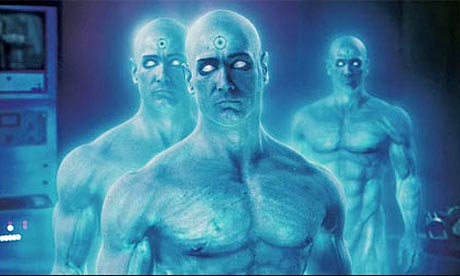
This movie is going to drive me crazy.
On one hand, it’s spectacular: everything I could have hoped for in an adaptation of one of the greatest graphic novels of all time. It had terrific casting, great acting, and an almost-entirely-faithful adaptation of the original material, albeit with some fairly nuanced changes. I even appreciate its multifaceted and deliberately murky handling of the politics and events of the era. In a lot of ways, this is a huge accomplishment as a film.
And yet, I can’t recommend it to a huge number of folks who otherwise would have really gotten something out of it, because it’s just far too graphic in ways it really didn’t need to be. In order for it to get a visceral reaction out of us jaded adults, it indulged in so much on-camera sex, nudity and violence that it put the movie completely off limits for a big part of its potential audience.
This is really weird thing for me to say, but for the first time in my life, I found myself sort of wishing I was watching the airplane-safe version of a movie in the theater, instead of what felt like the “unrated director’s cut” [actually, it’s ‘R’-rated–and a hard ‘R’ at that]. Had it been edited toward a PG-13 (or even a softer R), the director would have had to pull back the edit just a little, and I’d be hailing it to anybody who’d listen as a tremendous filmmaking achievement.
Instead, I’m oddly forced to make any recommendation contingent on my best guess at the sensibilities of the person doing the asking: How does the person asking feel about seeing more full-frontal male nudity than I saw in my high school locker room during swim season? Not many people have a problem with gunfights, but how do they feel about close-ups of exit wounds? Action-packed dust-ups with super-heroes are great, but how about cut-aways to the resulting protruding bone spurs? And what’s their position on entrails splattered on ceilings?
In the end, it comes down the infamous “blood in the gutters” — not the literal kind (as you see when the Comedian’s body splats onto the pavement”) but the comic book concept that most of the really tough imagery doesn’t actually happen “on-panel”. It’s usually implied, or shown briefly, and the reader’s imagination makes up the rest during the space between the panels–the “gutters”.
Let’s say a scene calls for a character to do something very nasty with a hatchet to another character. In most comics—including the Watchmen graphic novel—the usual way of dealing with it is to set up the situation, then do something like showing a silhouetted window view with one character raising the hatchet out, arm flexed, behind the unsuspecting person. To anyone paying attention, it’s crystal clear what’s happening, but the worst violence happens in your mind—not on the page.
After I got done watching Watchmen, I had to go back over a couple of the more visceral bits and compare them to the graphic novel’s treatment, because I couldn’t remember clearly whether I had just imagined certain of the most grisly or adult-oriented scenes. In almost every case, the situation was exactly the same, complete with all the terrible details. But the graphic novel tended not to show the hatchet crashing down repeatedly into the skull; or the bits of gore coming off of a wound. And it knew enough to crop the frame upward by 10% so we knew Dr. Manhattan couldn’t be bothered with clothes, but we weren’t actually forced to stare at his junk in every other one of his scenes.
I’m afraid that with Watchmen, a little less would have been a lot more: both in box office receipts and in my ability to recommend it to anyone other than jaded R-rated movie fiends like myself. I would have been happy to watch the version I saw as part of a special-edition DVD, but I really sort of wish the theatrical version had been edited with just a little more restraint.

Pingback: Daft Musings » Blog Archive » The Art of Artistic Restraint